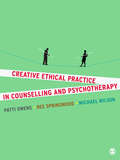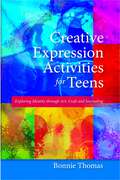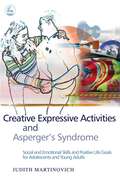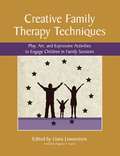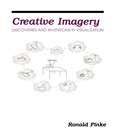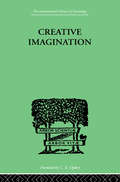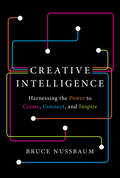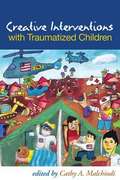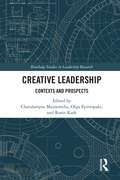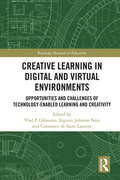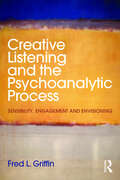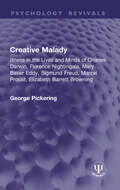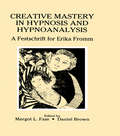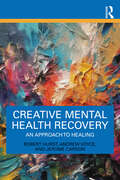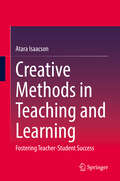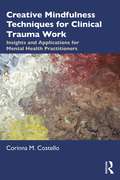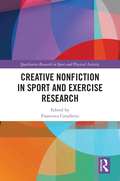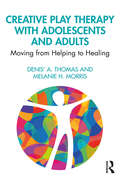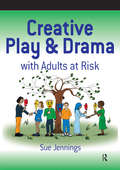- Table View
- List View
Creative Ethical Practice in Counselling & Psychotherapy
by Michael Wilson Patti Owens Bee SpringwoodCan I be a creative therapist without overstepping boundaries and risking complaints? Can I practise safely and ethically whilst remaining true to my humanistic values? This book answers ′Yes′ by offering a safety net to trainees and therapists working in the context of today′s ′complaints culture′. Exploring what safe and creative practice means in relation to the key cornerstones in therapy, the authors offer practical guidance to assist the reader in reflecting on and negotiating the challenges of boundaries, legalities and defensive practice. Creative Ethical Practice for Counselling & Psychotherapy considers the necessary structures and processes that must inform creative, humanistic practice for it to be a safe, ethical therapeutic framework. Packed with reflective exercises, summaries, case examples and step-by-step guidance, this book takes the reader from establishing the therapeutic relationship to worst-case scenarios like complaints procedures and legal action. It is essential reading for legal & ethical modules on all counselling courses. Patti Owens, Michael Wilson and Bee Springwood are all humanistic and integrative therapists and members of the UK Association of Humanistic Psychology Practitioners (UKAHPP) as well as the United Kingdom Council for Psychotherapy (UKCP).
Creative Expression Activities for Teens
by Bonnie ThomasCoping with life's stresses is difficult for everybody, but can be especially challenging for teenagers, who often feel isolated and misunderstood. Creative expression through art, craft, and writing is a natural and effective way of helping young people to explore and communicate personal identity. This book is bursting with art and journal activities, creative challenges, and miniature projects for bedrooms and other personal spaces, all of which help teenagers to understand and express who they are and what is important to them. These fun ideas can be tailored to suit the individual, and require minimal equipment and even less artistic know-how, so can be enjoyed by all. The book concludes with a useful section for counselors and other professionals who work with young people, which explains how these activities can be incorporated into treatment goals. This imaginative and insightful book is a useful resource for all therapists, social workers, and counselors who wish to encourage self-expression in teenagers.
Creative Expressive Activities and Asperger's Syndrome: Social and Emotional Skills and Positive Life Goals for Adolescents and Young Adults
by Judith MartinovichIndividuals with Asperger's Syndrome (AS) benefit from a positive, affirming support of their individuality. This forward-looking book focuses on building individual strengths and resilience, rather than modifying perceived weaknesses, through individualized therapy within a group context. Integrating psychological and educational theory with a variety of creative therapies, Judith Martinovich combines activities such as art making, drama, music, puppetry, yoga and photography with conventional cognitive behavioral interventions to support individuals with AS. The different activities complement and reinforce each other and are designed to address specific traits of the autism spectrum to aid skills development. Although created primarily for use with adolescents and young adults, the practical and versatile activities can be adapted for different age and skill levels, objectives and settings. Informed by contemporary research, they meet the objectives of a framework of principles drawn from Positive Psychology and Social and Emotional Learning. Creative Expressive Activities and Asperger's Syndrome is a comprehensive resource for parents as well as teachers, social workers, psychologists and arts therapists who wish to link therapeutic goals with creative activities for people with or without Asperger's Syndrome.
Creative Family Therapy Techniques: Play, Art, And Expressive Activities To Engage Children In Family Sessions
by Liana LowensteinBringing together an array of highly creative contributors, this comprehensive resource presents a unique collection of assessment and treatment techniques. Contributors illustrate how play, art, drama, and other approaches can effectively engage families and help them resolve complex problems. Practitioners from divergent theoretical orientations, work settings, or client specializations will find a plethora of stimulating and useable clinical interventions in this book.
Creative Ideas for Solution Focused Practice: Inspiring Guidance, Ideas and Activities
by Judith Milner Steve MyersExploring creative ways to implement solution focused practice, this book is packed full of ideas to inspire ways of working with clients which focus on their strengths as a means to finding solutions. Outlining how and why strengths-based interviewing for solutions is effective, the book provides a wealth of different ways to apply key solution focused techniques. With exercises, sample questions and top tips for tricky situations, the authors show how to apply creative methods in a variety of different settings and with different service user groups. Suitable for use with children and adults, this accessible book will offer exciting ideas for those new to solution focused working as well as more experienced practitioners looking for inspiration.
Creative Imagery: Discoveries and inventions in Visualization
by Ronald A. FinkeBringing together the results of experiments on discovery and invention in visualization conducted by the author over a three year period, this book reports new findings on the generation of creative inventions and concepts using mental imagery, and proposes a reconceptualization of the creative process. Creative Imagery introduces the concept of “preinventive forms” and describes an approach to creative invention differing from those typically used in problem-solving studies. There are two unique features of this book. First, it combines the experimental methods of cognitive science with the opportunity to explore and discover creative inventions in imagination. Second, it provides readers with numerous opportunities to use the creative imagery techniques to develop their own inventions and conceptual discoveries. This text is of particular interest to scientists working in the fields of experimental psychology, cognitive psychology, and cognitive science. The techniques for generating creative inventions will also be of interest to people working in engineering, architectural design, and the visual arts.
Creative Imagination: STUDIES IN THE PSYCHOLOGY OF LITERATURE
by Downey, June EFirst published in 1999. Routledge is an imprint of Taylor & Francis, an informa company.
Creative Intelligence: Harnessing the Power to Create, Connect, and Inspire
by Bruce NussbaumOffering insights from the spheres of anthropology, psychology, education, design, and business, Creative Intelligence by Bruce Nussbaum, a leading thinker, commentator, and curator on the subjects of design, creativity, and innovation, is first book to identify and explore creative intelligence as a new form of cultural literacy and as a powerful method for problem-solving, driving innovation, and sparking start-up capitalism.Nussbaum investigates the ways in which individuals, corporations, and nations are boosting their creative intelligence — CQ—and how that translates into their abilities to make new products and solve new problems. Ultimately, Creative Intelligence shows how to frame problems in new ways and devise solutions that are original and highly social. Smart and eye opening, Creative Intelligence: Harnessing the Power to Create, Connect, and Inspire illustrates how to connect our creative output with a new type of economic system, Indie Capitalism, where creativity is the source of value, where entrepreneurs drive growth, and where social networks are the building blocks of the economy.
Creative Interventions in Grief and Loss Therapy: When the Music Stops, a Dream Dies
by Thelma DuffeyGet the tools to help the grief that comes when a dream diesEvery person at one time or another suffers when his or her dreams are shattered. Creative Interventions in Grief and Loss Therapy: When the Music Stops, a Dream Dies provides truly innovative approaches to therapeutically help individuals work through and survive grief and loss. Leading experts explore creative interventions for common, yet emotionally devastating problems faced by those weathering the storms of grief after their dream has been destroyed. Therapists and counselors get the effective tools to creatively help people through the difficulties of dealing with death, addiction, trauma, changes in life circumstances, divorce, heartbreak, miscarriage, co-occurring mental health and substance use disorder (COD), suicide, adoption, and issues with children.The chapters in this innovative volume cite existing research on specific grief and loss issues and illustrate a clinical application for each situation using various creative mediums such as music, writing, or ritual. Each approach can be expanded and modified with care by clinicians of all types to better help clients through the process. This resource is extensively referenced.Topics in Creative Interventions in Grief and Loss Therapy include: how storytelling, journaling, and correspondence can be used to process the experience of a counselor’s loss following the death of their client using psychodrama and the utilization of empty chair techniques to address addiction related grief and loss the use of rituals as an intervention to help clients trauma and loss during times of natural disasters the process of gatekeeping by counselor educators Emotional Freedom Technique (EFT) as an approach to help student athletes deal with life after the sport a literary exercise to help clients work toward forgiveness after divorce using books, songs, and projects to assist clients experiencing grief after the death of their adolescent child creative strategies to aid clients through the grief and loss of love effective interventions to assist clients through loss from miscarriage using music, videography, visual arts, literature, drama, play, and altar-making in the grief process innovative interventions for individuals with co-occurring mental health and substance use disorder suicide high risk factors—and a Pre-suicide Preparation Plan that mental health practitioners can implement creative intervention for the client who is adopted using super heroes and science fiction therapeutic storytelling for children in grief Creative Interventions in Grief and Loss Therapy: When the Music Stops, a Dream Dies is a creative, reaffirming resource perfect for mental health professionals, therapists, counselors, social workers, educators, and students.
Creative Interventions with Traumatized Children
by Cathy MalchiodiRich with case material and artwork samples, this volume demonstrates a range of creative approaches for facilitating children's emotional reparation and recovery from trauma. Contributors include experienced practitioners of play, art, music, movement and drama therapies, bibliotherapy, and integrative therapies, who describe step-by-step strategies for working with individual children, families, and groups. The case-based format makes the book especially practical and user-friendly. Specific types of stressful experiences addressed include parental loss, child abuse, accidents, family violence, bullying, and mass trauma. Broader approaches to promoting resilience and preventing posttraumatic problems in children at risk are also presented.
Creative Interventions with Traumatized Children, Second Edition: Creative Arts And Play Therapy, Eds Malchiodi And Crenshaw (Creative Arts and Play Therapy)
by Bruce D. Perry Cathy A. MalchiodiA trusted, bestselling resource, this volume demonstrates a range of creative approaches for facilitating children's emotional reparation and recovery from trauma. Experts in play, art, music, movement, and drama therapy, as well as bibliotherapy, describe step-by-step strategies for working with children, families, and groups. Rich with case material and artwork, the book is both practical and user-friendly. Specific types of stressful experiences include parental loss, child abuse, family violence, bullying, and mass trauma. Important developments in neurobiology, self-regulation, and resilience and posttraumatic growth are highlighted in this substantial revision. New to This Edition: *Chapters on art therapy and EMDR, body maps and dissociation, sandtray play, resiliency-based movement therapy, work with clay, mindfulness, and stress reduction with music therapy. *Updated and expanded discussions of trauma-informed therapy and the neurobiological basis for creative interventions. *The chapter on mass violence has been extensively rewritten with new case material on the Sandy Hook school shooting. This e-book edition features 65 full-color illustrations. (Illustrations will appear in black and white on black-and-white e-readers).
Creative Intimacy: How to Break the Patterns That Poison Your Relationships
by Jerry A. Greenwald"The pressures of modern living and the complexities of transient relationships prevent us from forming deeply intimate bonds with one another. Real, lasting intimacy, though difficult to attain, is a precious gift that we all desire and deserve. Now, in this breakthrough book, Dr. Jerry, famed therapist and best-selling author of Be the Person You Were Meant to Be, reveals a foolproof method structured to help everyone attain total lifetime contentment. Stressing that no one is too unattractive, too failure-prone or too old to create a fulfilling intimate relationship, Dr. Greenwald does believe that many people are too timid, too insecure or just afraid to take the first positive steps. These steps, and the simple ones that follow, are clearly outlined in Creative Intimacy. Digging deep into Gestalt therapy, the book demonstrates how to develop a healthy 'yes' attitude and still know when to say 'no'; how to avoid detouring your life into blind alleys that create self-diminishing, self-defeating patterns; how to abandon the 'happily ever after' myth and deal with reality; how to employ the 'no' process as a weapon against emotional fragmentation and toxic intrusion; and how to build psychic-space and gain the rewards that belong to us all--an open, flexible, adaptable and optimistic nature and an intimate relationship that is a prime source of stability, security and emotional nourishment. Creative Intimacy is waiting for you. Gain new techniques, new enthusiams and a new ability to reach out and find your intimate other. Begin learning how to achieve creative intimacy today. The past does not dictate the future, patterns can be broken, and true intimate relationships can be a reality for everyone." On an academic level, this book provides students and professionals with constructive psycho-therapeutic techniques to use with their clients.
Creative Leadership: Contexts and Prospects (Routledge Studies in Leadership Research)
by Ronit Kark Charalampos Mainemelis Olga EpitropakiThere has never been a better time to study, practice, and experience creative leadership. In the fluid and turbulent economic and social environments of the 21st century, creative leadership has become a cardinal force in the creation and evolution of adaptive organizations. In the last two decades, organizational science has witnessed a rapid increase in the number of studies on the nature, skills, and processes of creative leadership. The resulting accumulated body of knowledge has remained for many years dispersed and fragmented across multiple strands of organizational research. This volume seeks to foster the cross-fertilization of scientific knowledge and insight by bringing together authoritative contributions from leading scholars whose work is located in different strands of creative leadership research. Creative Leadership: Contexts and Prospects builds upon a recently introduced multi-context framework that integrates metatheoretically three conceptualizations of creative leadership found in the extant literature: Facilitating employee creativity; Directing the materialization of a leader’s creative vision; and Integrating heterogeneous creative contributions. These three conceptualizations reflect essential differences in the enactment of creative leadership across various collaborative contexts of creative work, and they underlie the intellectual efforts of different research strands. The collection of chapters in Creative Leadership: Contexts and Prospects offers the latest thinking on creative leadership in facilitative, directive, and integrative contexts, and a stimulating set of ideas for crafting the next generation of nuanced theories and empirical studies in the field.
Creative Learning in Digital and Virtual Environments: Opportunities and Challenges of Technology-Enabled Learning and Creativity (Routledge Research in Education)
by Vlad P. Glăveanu; Ingunn Johanne Ness; Constance de Saint LaurentOriginally published as a special issue of the Creativity Research Journal, this volume gives a balanced and reflective account of the challenges and opportunities of technology-enabled creative learning in contemporary societies. Providing a current and updated account of the challenges posed by the Coronavirus to online education, chapters more broadly offer conceptual reflections and empirically informed insights into the impact of technology on individual and collective creativity and learning. These thoughts are explored in relation to school achievement, the development of digital educational resources, online collaboration, and virtual working. Further, the book also considers how the creative use of technology poses risks to learning through the accidental or deliberate dissemination of misinformation, and online manipulation of common societal values in the era of COVID-19. Creative Learning in Digital and Virtual Environments looks at the connection between creativity, learning, and school achievement, and analyses the impact of virtual environments on creative expression. It will appeal to postgraduate students in the fields of creativity and learning, as well as to students and academics involved with broader research in areas such as the role of technology in education, e-Learning and distance education. Vlad P. Glăveanu is Associate Professor and Head of the Department of Psychology and Counselling at Webster University Geneva, Switzerland, as well as Associate Professor II at the University of Bergen, Norway. Ingunn Johanne Ness is a Senior Researcher at the Centre for the Science of Learning & Technology, University of Bergen, Norway. Constance de Saint Laurent is a Postdoctoral Researcher at the University of Bologna, Italy.
Creative Listening and the Psychoanalytic Process: Sensibility, Engagement and Envisioning
by Fred L. GriffinContemporary psychoanalytic thinking about the interdependence of subjectivity and intersubjectivity has reenvisioned the analytic process, and with it the very nature of creative and engaged psychoanalytic listening. Yet few systematic writings on psychoanalytic listening or technique provide comprehensive instruction that would prepare the analyst for the kind of analytic listening needed to participate imaginatively in this sort of intersubjective experience.Offering a short course in analytic listening, Creative Listening and the Psychoanalytic Process provides a guide for the clinical uses of imaginative literature. Outside the psychoanalytic literature, extraordinary pieces of imaginative literature exist that provide the kind of experience in analytic listening that can guide clinicians in their work with patients. Certain works of fiction create textured, sensory worlds in which complex characters possessing shifting states of consciousness live within fluid emotional atmospheres. In this book, Fred Griffin demonstrates that by entering the worlds that original writers create in their texts, the psychoanalytic therapist will learn to attend more closely to varying emotional states that generate nuanced, multidimensional views of the analysand’s internal and relational worlds. He illustrates how these works capture more fully the sensory experience encountered by psychoanalysts when taking in what the patient communicates within the analytic space. Creative Listening and the Psychoanalytic Process presents case material alongside selected passages from works of fiction written by a range of creative writers, each of which stimulates analytic sensibility about this clinical experience. A conceptual framework is provided that makes these and other original works of fiction more accessible for these purposes. This book will be essential reading for psychoanalysts and psychoanalytic psychotherapists, as well as professors and graduate students studying psychoanalysis and literature. It will also appeal to literary scholars and those teaching and practicing in the field of narrative medicine.
Creative Malady: Illness in the Lives and Minds of Charles Darwin, Florence Nightingale, Mary Baker Eddy, Sigmund Freud, Marcel Proust, Elizabeth Barrett Browning (Psychology Revivals)
by George PickeringIn this highly provocative book, originally published in 1974, Sir George Pickering, former Professor of Medicine in the University of London and Regius Professor in the University of Oxford, examines the role of illness in the minds and lives of Charles Darwin, Florence Nightingale, Freud, Proust, Elizabeth Barrett Browning and Mary Baker Eddy.At the age of twenty-six Darwin returned from the voyage of the Beagle a vigorous young naturalist. Within two years he became a recluse and so remained until he died. Florence Nightingale came back from the Crimea at the age of thirty-six a national heroine. Within a year she was an invalid, within two bedridden. Yet she lived to ninety. Both used illness as a social ‘weapon’: Darwin, so that he could give his undivided attention to the theory of evolution; Florence Nightingale to bludgeon reluctant officials and to keep unwanted relatives at bay.With Mary Baker Eddy, Freud, and Proust psychological illness played a totally different role. Christian Science, psychoanalysis and À la recherche du temps perdu each owed its very existence to its creator’s attempted or successful self-cure – while with Elizabeth Barrett Browning, who at first sight seems a similar psychological creator, illness and creativity turn out to have no link.Creative Malady is a masterpiece of biographical detective work. For the first time the relationship between illness and creativity was explored. Each of the eminent Victorians described was possessed by a dominating passion and in each case the author shows what happened when that passion was thwarted or fulfilled. Today it can be read in its historical context.This book is a re-issue originally published in 1974. The language used and views portrayed are a reflection of its era and no offence is meant by the Publishers to any reader by this re-publication.
Creative Mastery in Hypnosis and Hypnoanalysis: A Festschrift for Erika Fromm
by Daniel Brown Margot L. FassThe scope of Erika Fromm's profound contributions to the clinical and research literature in hypnosis and related areas is reflected in this volume, which consists of chapters written by those who have worked closely with the noted psychologist and/or have been significantly influenced by her. The subject matter presented here ranges from detailed accounts and personal observations relating to Fromm's distinguished career, to some very new and valuable data on the psychophysiological correlates of hypnosis, the phenomenology of self-hypnosis, and an integrative model for short-term therapy. Several extensions of clinical technique for the treatment of trauma and severe psychopathology are also discussed. Professional therapists with an interest in personal growth, self-awareness, and creative mastery, whether or not they already have an interest in hypnosis, will derive significant benefits from this book. Readers who have previously eschewed hypnosis may find that this volume stimulates an interest that enriches their clinical practice and/or research.
Creative Mental Health Recovery: An Approach To Healing
by Jerome Carson Robert Hurst Andrew VoyceThis book presents the importance of the role of creativity, particularly everyday creativity, in the lives of people on a mental health recovery journey.Through a review of historical and contemporary literature and research findings on the topic, the book starts by giving readers an idea of the state of play of conceptualisations of both creativity and recovery. The authors arrive at and present their own definitions of these concepts, using autoethnography to bring their own experiences into the text. They then illustrate to the reader what creativity in recovery looks like in practice, through interviews with and written accounts from creative individuals who have experienced a mental health recovery journey, grounding the theory with tangible stories of application. The interviews are analysed, with themes picked out and a model of creativity and recovery produced by the authors. Implications and possible future directions are then discussed.This unique presentation of creative recovery will be of interest to a wide range of mental health professionals, specifically those studying or practising mental health recovery and creative therapies.
Creative Methods in Schema Therapy: Advances and Innovation in Clinical Practice
by Gillian HeathCreative Methods in Schema Therapy captures current trends and developments in Schema Therapy in rich clinical detail, with a vividness that inspires and equips the reader to integrate these new ways of working directly into their practice. It begins with creative adaptations to assessment and formulation, including the integration of body methods to promote engagement and to bring about early emotional change. Other chapters introduce innovative methods to lift a formulation off the page and it goes on to bring to life new developments across all aspects of the ST change repertoire, including limited reparenting, imagery, trauma processing, chair work, the therapy relationship, empathic confrontation and endings. For the specialist, there are chapters on working with forensic modes, eating disorders and couples work. Finally, the book includes chapters on the integration of key principles and techniques from Cognitive Behavioural Therapy, Emotion Focused Therapy and Compassionate Mind work into a core schema model. The book will appeal not only to full-fledged schema therapists, but also to junior therapists and therapists from other modalities who are willing to enhance their ways of working.
Creative Methods in Teaching and Learning: Fostering Teacher-Student Success
by Atara IsaacsonThis book explores teaching methods that foster creative thinking among students across various disciplines. It presents effective experiments conducted in workshops with both practicing teachers and student teachers, aiming to modernize existing teaching approaches to better align with the needs of the 21st century. The central argument is that adopting such methods will generate interest and engagement for both learners and educators, while also positively influencing teacher-student relationships and student achievement. The book clarifies and redefines the role of the teacher as an influential and formative figure, even as this role has evolved. It offers strategies to overcome obstacles to learning and suggests engaging approaches to creative activities. This book is intended for teacher educators, researchers, and teachers who deeply value education. Dr. Atara Isaacson is an interdisciplinary researcher and senior lecturer at the Faculty of Education and the Department of Music at Bar-Ilan University. Her work centers on fostering creative thinking in teaching and learning, exploring teacher-student relationships, arts education, and 19th-century music. She is the author of four books in Hebrew—two focused on musicology, and two on education and music education.
Creative Mindfulness Techniques for Clinical Trauma Work: Insights and Applications for Mental Health Practitioners
by Corinna M. CostelloUsing evidence-based creative mindfulness techniques (CMT), this book acts as a useful guide for clinical mental health practitioners seeking to build resilience levels in clients recovering from trauma. It examines the effectiveness of the CMT approach, providing applicable art therapy techniques to enhance the therapist’s toolbox for clinical effectiveness. Combining a psychodynamic and neurobiological clinical lens, this book helps practitioners recognize and utilize creativity in dealing with trauma exposure, its cultural considerations, and its consequences on the individual, family, and the system. It also provides insights into the neurophysiological impact of mindfulness techniques on the brain. Chapters explore the clinician’s role in the treatment of trauma, wellness, and the building of resiliency, creativity, and alternative approaches to changing neural pathways, positive psychology, and more. A collection of narrative case studies and guidance for specific activities to be used with diverse clients ensures easy practical usage of the theories explored. Clinical mental health practitioners who work with clients suffering from PTSD, clinical trauma, stress, and anxiety will find this book essential.
Creative Nonfiction in Sport and Exercise Research (Qualitative Research in Sport and Physical Activity)
by Francesca CavallerioAcademics around the world recognise the effectiveness of storytelling as a way to engage audiences in conversations, raising awareness of issues, and encouraging change. Stories are now seen as the best medium to convey information to diverse audiences. This book explores a novel approach to representing research findings through the adoption of creative nonfictional stories (CNF). At a time when dissemination of scientific research is constantly highlighted as a fundamental aspect for academics, CNF represents an opportunity to effectively communicate science to non-academic audiences through stories. By providing practical examples of how to transform findings into compelling stories rooted in data, following the mantra of showing rather than telling, which characterises CNF, Creative Nonfiction in Sport and Exercise Research helps researchers – qualitative, quantitative, established professors, and students – to turn their research into stories. A unique contribution to the field, this book is the first in the sport and exercise research field to take scholars on a discovery jouney, moving from their classic realist to a more creative, compelling, but still rigorous representation of research findings. The book features chapters written by authors from different sport research backgrounds, who present the findings of a previously published ‘classic’ study rewritten in the form of a story. Reflective chapters focusing on the how-to and the challenges of this creative analytical practice complete the work, to support scholars in developing their creative skills.
Creative Play Therapy with Adolescents and Adults: Moving from Helping to Healing
by Denis' A. Thomas Melanie H. MorrisThis practical, user-friendly manual shows mental health professionals how to implement play therapy with adolescents and adults and how to conceptualize client struggles using a wealth of creative approaches. Creative Play Therapy with Adolescents and Adults follows an accessible seven-stage process for professionals to address clients’ core needs and establish an empathic therapeutic relationship. The book charts the stages of play therapy and explores a range of expressive arts including art, drama, dance, writing and sand play and the key materials needed for each. It also considers additional aspects of play therapy including resistance, spirituality and self-care. Filled with techniques, skills and case studies to help demystify complex client work, the book outlines an easy-to-follow treatment protocol for healing and resolution. This book will be of interest to a wide range of mental health professionals working with adults and adolescents as it encourages a more creative career and lasting, tangible progress in clients.
Creative Play and Drama with Adults at Risk
by Sue JenningsThis hands-on manual offers a clear introduction to play and drama work for professionals working with adults at risk. Many adults feel nervous about drama and think that play is childish. Sue Jennings shows that by participating in play and drama people can make a difference to how they feel about themselves and the world around them. This book is suitable for professionals working with adults who are vulnerable for a number of different reasons: those who have addictions such as eating disorders, drug and alcohol abuse or a history of violent relationships; adults with mental ill health; individuals and families with behavioural difficulties; people in forensic settings; those with multiple disabilities; learning impaired adults; people with strokes and other physical impairment often as a result of accidental injury. Material is chosen sensitively to enable confidence and creativity building, and the development of communication skills. Photocopiable worksheets offer the professional activities that will encourage trust and collaboration; foster independence and choice, maximise people's learning potential and stimulate everyone's imagination and creativity. Ideas are given for improvisation and movement as well as masks and myths. Cross-cultural perspectives are discussed together with boundaries for clinical groups. The importance of the healing potential of artistic expression is addressed throughout.
Creative Play in Family Therapy: Effective Strategies and Interventions for Child-Centered Treatment
by Lisa René ReynoldsThis practical resource integrates family therapy theory with playful interventions and techniques to allow family therapists to successfully engage and include children in the session.Many therapists who are trained in family therapy lack training in child-centered play techniques. This book effectively bridges the gap between popular theories and models in family therapy and the practice of working with children in a family context. Showcasing playful therapy techniques across and within each of the most common models of a family therapy such as Experiential, Structural, and Narrative Therapy, and Psychodynamic and Cognitive Behavioral Therapy (CBT), this book is accessible to a wide range of clinicians. Additionally, the author offers clear tangible interventions adaptable for both in-person and teletherapy sessions.This book is essential reading for practicing therapists, students in training, clinical supervisors, and anyone who works with children in a therapeutic capacity.
